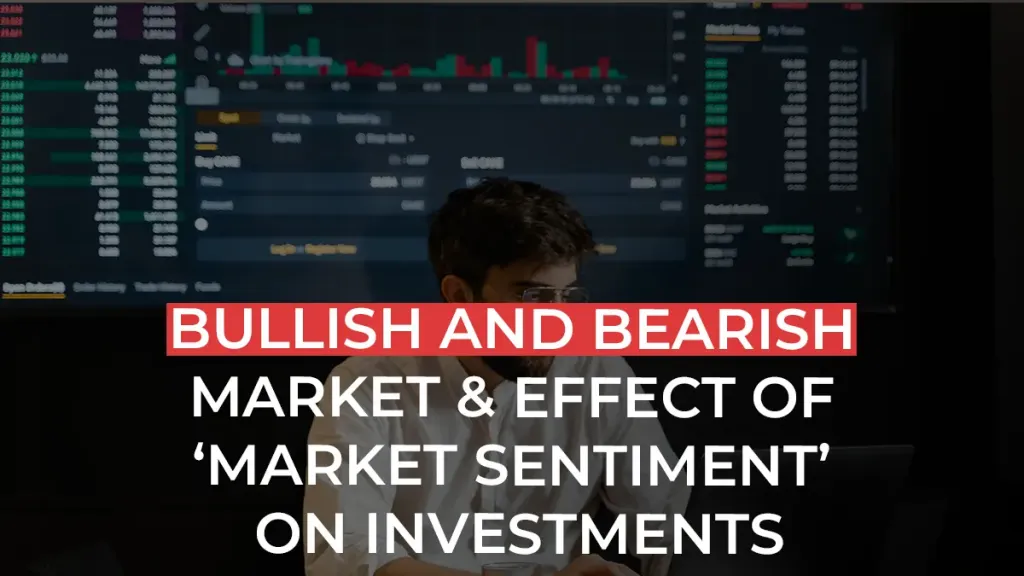Bullish and Bearish Market & Effect of ‘Market Sentiment’ on Investments

Here's What We've Covered!
The Indian Stock market is based on two E’s – Earnings and Emotions. Earnings are an important factor that affects the stock of the company and Emotions and sentiments are a huge part of investing.
Was it only earnings that drove the Sensex to 21000 in January 2008 or a low to 8700 in October in 2008? Well, not really. The sentiment and emotions of investors played a huge role in the fall and rise of Sensex. When we hear a piece of positive news it increases the interest in the company and increases the buying interest, on the other hand, negative news ruins the prospects’ stock to increase in value.

What is Bullish Market?
The bull market is the state of financial markets where the prices are continuously rising for an extended period. A bull market can last for months and even for years.
Bull markets can be characterized by strong positive expectations of the economy, positive consumer sentiment.
What is Bearish Market?
A bear market is essentially the opposite of the bull market. In this phase, the price of the securities is falling continuously which also encourages selling this is because many of the investors choose to sell their stocks with the fear of bearing additional losses. These fuels fear and negative sentiment in the market
Bull markets are cyclical last for a couple of weeks or months. However, secular bear markets can last even for years.
What Is Market Sentiment?
As seen before Market sentiment is being bearish or bullish ie having a positive and optimistic outlook or having a negative and pessimistic outlook. Market sentiment is a cyclical behavior driven by human emotions.
As seen below Bull market is when the emotions are optimistic, excitement, thrill and euphoria. During this time there is maximum financial risk. After this, the negative emotions like anxiety, denial, fear, desperation, panic, capitulation and despondency take over. This is when the asset prices have fallen (bear market) and this is the time of maximum financial opportunity for investors. After this, the cycle turns again and the sentiment turns positive to hope, relief and optimism.
Let us look at a few examples of how Market Sentiment has affected the Indian market –
Impact of 2017 Budget on market
There were some major moves in the stock market during the then finance minister Arun Jaitley’s budget speech in 2017. Before preceding, the speech Sensex and Nifty started rising steadily and gained an additional percent till the time he finished the speech.
When the finance minister gave his speech Sensex was up more than 300 points while Nifty was up 80 points this gave the investors a euphoric feeling. The Indian rupee also rallied on the budget day. The small-cap as well the midcap stocks were up in the rally. Investors observed large volatility in their portfolio during this time.
Let us look at another example of how Reliance share price was affected due to market sentiment –
In the current times, the telecom industry is observing large volatility and declining investor confidence and negative sentiment. And guess what is the main reason behind this? The answer is Reliance Jio! Reliance Jio is trying hard to get an upper hand in the telecom sector by streaking out its competitors.
This was also because of the bull market in Sensex and Nifty during that period. Investors were optimistic and excited about Jio’s initiatives to capture the Indian telecom market and wipe out its competitors.
The market reached a new high in August at 830. Post that the share prices fell in September. However, it touched the high of 830 again but was not able to break the high. Post that investors started to panic and became more skeptical and started selling their stakes and the price started tumbling down.
Do you remember Bitcoin?
Yes, it was the most “hot” investment option two years back but have you heard of it or any other cryptocurrency now? NO! But what happened and how did the most favorite talk about investment option come down so quickly?
Towards the beginning of 2017 bitcoin gathered substantial attention. Every news channel, the newspaper was drawing people’s attention to the rise of Bitcoin. Investors very excited and everyone wanted to cash on it. However, this phenomenon did not last for long.
In India and many other countries announced that it did not back Bitcoin. This was among the many other factors that led to the fall of Bitcoin. Investors started panicking and started selling their share this lead to significant losses for investors who had invested in bitcoin during that time. Investors who purchased Bitcoin in December 2017 and their investment was down by more than 50% during February 2018. For investors who did not sell during this time and were holding on to their investment until June saw the value going down by 60%. Bitcoin now is rarely mentioned how it was before and may not recover the lost ground ever in the future.
Conclusion
Hope you understood how market sentiment impacts investments. But since this is an intangible feeling it is difficult to measure. Market sentiment can be measured through surveys and indicators. Be aware of the impact of market sentiment and try to identify the measures. Remember the goal is to buy low and sell high.
Read more: Everything you need to know about Equity Investments
Resent Post
>
How to Find ACCA Jobs Online After Qualifying: Real Portals, Tips & Career Guidance
>
Financial Modelling Classes in Hyderabad: Your Guide to the Best Institutes
>
Still Paying CFA Enrollment Fees? Here’s the Big 2026 Update!
>
How to Use myACCA Like a Pro: Dashboard, Exams, Deadlines & More!
>
Difference Between Financial Accounting and Management Accounting: A Complete Guide



